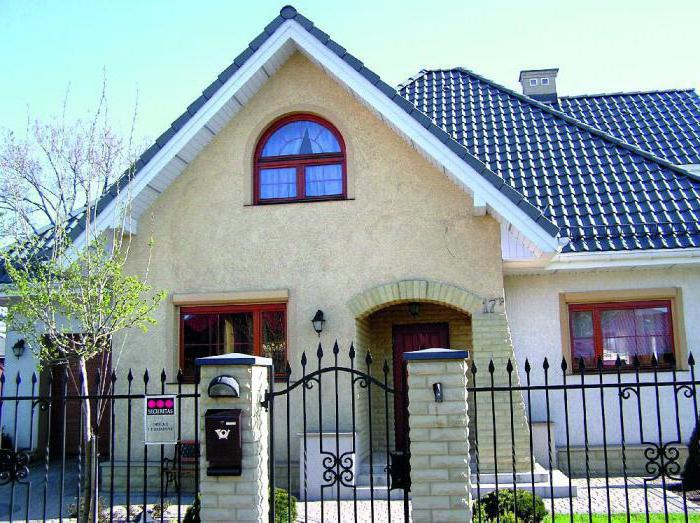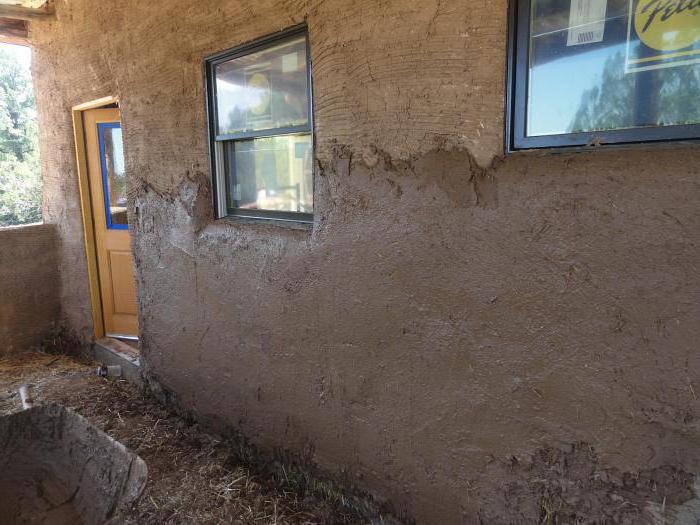Decorative plaster for outdoor works: description and technology of application
The appearance of any building, let alone residentialhome is of great importance. Therefore, the finishers and pay much attention to the procedure for the decoration of the facade. And if earlier it was difficult enough with this question, as sometimes it was necessary to almost literally almost invent the compositions of all kinds of solutions, today the market of building materials is ready at any moment to come to the rescue as a professional or a home master. To date, there is a huge number of all kinds of mixtures for the decoration of external walls of buildings, and the most popular is decorative plaster for outdoor works. This is not surprising, since this material has a lot of advantages and a meager number of shortcomings.

About what has the pros and cons of decorative plaster for outdoor works, its types, basic characteristics and technique of application, we'll talk in our article.
Positive traits
Facade decorative plaster for exteriorworks not only creates an attractive texture structure, it also protects the wall surfaces from moisture, that is, it is like a kind of shield for the outer surface of the walls. In addition, it is characterized by very, very high resistance to all kinds of temperature changes, and therefore the facade of the house finished with its help retains its original appearance long enough. It should not be discounted that it significantly increases the heat-insulating qualities of the walls, and also makes them less permeable to sound.
It allows you to implement many ideas for creatingexterior of the building, because, thanks to the special composition of each kind of this finishing material, it is possible to make various textured surfaces with its help. For example, decorative plaster "bark beetle" for outdoor work imitates the surface of wood, eaten by bugs, and the mixture of "fur coat" somewhat resembles the inner fur surface of sheepskin.
In addition to the basic composition, in this finishingmaterial is available all kinds of additives - the so-called fractions, consisting of crushed minerals. Choosing a particular size of the fraction, you can create a completely different structure of the coating. In addition, in addition to the basic shades (white and gray), you can buy and already painted material. The choice of colors is quite diverse, in the same case, if the suitable one was not found, it is possible to add the pigment pigment to the composition itself.
And one more huge plus that possessesdecorative plaster for outdoor works. It perfectly hides small defects, special preparation is not required before the beginning of the work, and the application process itself is quite simple. In this regard, if you have a pair of skilled hands, you can apply all the finishing work yourself.

A spoon of tar…
True, it is not that big.The main disadvantage is that the whole prepared solution needs to be worked out within a certain period. That is, there are no breaks for smoke breaks. To sustain such a pace in the absence of appropriate skills of finishing works is quite difficult. The second minus is directly related to the next question, which we want to consider further. These are types of decorative plasters for outdoor works. There are both simple compositions, and complex, better ones. But they are much more expensive. In other words, if you want to make a better façade by acquiring a material with improved (however, already without it bad) characteristics, then finishing you will be very expensive.
In the following, we briefly review the species currently existing.
Cement plaster
It is made on the basis of cement and fractionalinclusions. Such decorative plaster for outdoor works has all the characteristics described above, but it is not sufficiently resistant to loads, and as a result, cracks may appear on the walls during shrinkage. But these plasters have an affordable price, in addition, the facades decorated with their use are easily amenable to restoration. Simply put: the defects that have appeared can be repaired in an elementary way, and outwardly it will not be noticeable. Another disadvantage is that the range of colors is rather poor, so it's not always possible to choose the shade of interest. Nevertheless, cement plaster is the most popular in finishing, which is not surprising, since the area of the facades is quite large, and therefore not every homeowner can afford to lay out significant sums for the purchase of better materials. The same, which can, it is recommended to pay attention to the following kind of finishing material.

Acrylic plasters
If the cement is produced in dry form, thisdecorative plaster for outdoor works (see photo below) is already realized ready-made, put up in buckets. In its composition there is an acrylic filler, which gives the composition the necessary plasticity, due to which the walls finished by it less suffer from the appearance of all kinds of defects and cracks. The color palette of such plaster already inspires respect, but to keep from buying can be quite high cost and the inability to apply on absolutely all kinds of surfaces. The most suitable option is for these purposes concrete.

Silicate variety
Has high qualitycharacteristics, contains in its composition special mineral fillers, perfectly adheres to the substrate, so that the list of surfaces to which it can be applied is significantly expanded. The color palette allows you to make practically no problems, but you can stop the cost of the compounds. For this reason, most often applied locally - when decorating particularly significant and prominent places of the building (columns, door and window slopes, curbs, etc.).
Silicone plaster
This "queen", as it is called by the master, is goodin every way. And it is applied on any surfaces, and its performance characteristics are stunning, it has almost any color and is not subject to deformation at all. However, due to its high cost, with external works is practically not applied. It is used most often for interior finishing works.
Types of textures
Talking about what constitutesdecorative plaster for exterior work, it is impossible to ignore one of its main qualities - the texture itself. From the choice of her entirely depends on the appearance of the finish. So, of the simplest, the front decorative “bark beetle” plaster already mentioned by us is often used for outdoor work. Next comes the “fur coat” (they also talked about it). Of the simple ones, the “lamb” stands in third place, after finishing which the walls look like fleece. Kameshkovaya plaster gives a small-hilly surface, and the mosaic is at least something similar to it, but more noble and imitates the surface, as if covered with shards of mica or other stone. Stone creates the illusion of finishing stone, limestone or marble. Terrazitovy after drawing is similar to tuff. There is also a kind of "graphite", which allows you to get a very peculiar texture, but working with it is very difficult and extremely expensive. That is why it is used most often only during the restoration of historic buildings.
Now that we’ve sorted it out, we’ll tell youwhat is a technique of applying facade decorative plaster. However, before a few words about the preliminary work, which should necessarily be carried out.

Substrate preparation
As we already mentioned, preliminary work is notrequire special effort. Since decorative plaster for exterior works rather well hides non-essential defects, there is no need to achieve a special smoothness of the surface. But it is imperative that all significant defects and cracks be repaired, including removing the protruding fragments, since eliminating them at the expense of the finishing material contributes to a considerable overrun of the composition. Then the base surface must be primed in order to improve its adhesive qualities. Numerous special blends are available for this procedure. Which is better to take for a particular type of plaster - the seller will tell you. In order to save, you can not overlook it and purchase a universal acrylic primer from any manufacturer. After the base surface dries, you can proceed to the application.

How to work with decorative plaster
Before we talk about the technique of application, it is worthpoint out a few nuances. First of all, the fact that all the mixed solution must be developed at one time. If it starts to dry out, then it is strictly prohibited to dilute it with water. Before mixing, the bag with dry plaster should be thoroughly shaken so that the fractions during storage to the bottom of the fraction are evenly distributed throughout the composition. Promotes this and thorough mixing in the preparation of the solution. By the way, ready-made compositions should also be carefully mixed before starting work. And further. You need to try to apply the solution in a literal sense from corner to corner in one go. If it is very necessary to take a break, then the layers can only be “joined” until the first one has completely dried up. Otherwise the transition will be noticeable.
Technique of application
The prepared solution is covered with a spatula ontreated area of the wall, and then with a trowel stretch it over the surface for a more uniform application. The thickness of the layer should correspond to the size of the fractions of the composition, which, as a rule, is indicated on the package. Immediately after it dries, which takes no more than ten minutes, the plastic trowel is used to form the desired image. That is, the tool is moved in the selected direction - up and down, back and forth, in a circle or at a given angle. If necessary, you can clear out the problem areas with sandpaper after complete drying, but no one does such work when finishing facades. Correction is applied only for internal work.

Conclusion
Textured plaster is great forfinishing the external facades of buildings. And if necessary, such work is strongly recommended to pay attention to it. The only thing that should be taken into account is the need for appropriate skills. Sometimes, it is not always advisable to independently conduct such work, given the scale. Sometimes it is better to seek the help of professionals. Especially if the decoration was bought not simple, but more expensive decorative plaster for exterior work. The cost of work is, depending on the region, an average of about three dollars per square meter. m
</ p>>







